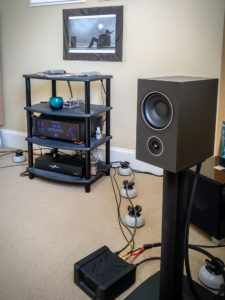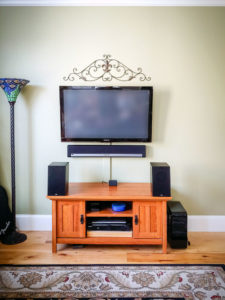Listening First Impressions
Hyperbole is assumed these days when a reviewer claims to be surprised by big sound from small speakers. What does “big sound” even mean? Usually, it’s about the bass. Many small speakers are designed to boost output just above low-frequency roll-off to help them sound bigger than they are. I heard no evidence of this trickery with the P5. Instead, the new Alpha welcomed me to that first listening session with evenness of tone and true in-room extension that’s well below their rated 55Hz anechoic response. This is bass that I could feel in my feet through the floorboards and that only intensified as I increased playback level. Even at average levels approaching 100 dB, the P5’s remained composed, showing only slight signs of dynamic compression.
But what surprised me more than bass output was the midrange. That aforementioned peak above LF roll-off combined with more efficient tweeters tends to give most small speakers a recessed midrange presentation. Not so with the P5. Vocals, snare drum, and piano have just the right attack and presence. Mids from the P5 have a wonderful “crunch”…although that may not be the most helpful aural descriptor. Think of this more as texture than sound and it may make a little more sense. It’s delightful how this characteristic, combined with the right recordings, brings the performance into the room. This was entirely unexpected from a $349/pair set of speakers.
Description of P5 Playing Different Types of Music
- Bye Bye Blackbird performed by Patricia Barber from Nightclub An audiophile favorite, this chart starts off with Barber’s piano and Marc Johnson’s upright bass playing in unison. Loudspeakers in this price range often struggle with the delineation, but the unique pitch, timbre, and attack of each instrument was clearly presented by the P5 in both time and space. Barber’s vocal emerged from the center of the stage a few bars in, but it’s not a detached head suspended between the speakers; the P5 revealed the presence of a body connected to that voice. There’s great clarity and presence with only the slightest hint of sibilance. Her piano solo emerged with powerful attack about 90 seconds in, filling the soundstage. Brushes on Adam Nussbaum’s snare delivered the full sound of the drum head, not just the typical “splat.” With just three performers, there’s a great sense of space in this recording, and the P5’s really pulled me in.
- Moon Dance performed by Kenny Barron & Mino Cinelu from Swamp Sally In this track, Barron and Cinelu acted like a couple of foley artists set loose in a huge studio full of percussion instruments. The soundstage was vast in all dimensions with a few phasey tones even appearing to come from my far left and right. Their playing progressed from sparse to ruckus, calling on the P5 for dynamics, resolution, and stop-on-a-dime articulation to render this piece with the intended immediacy. It all translated beautifully while the speakers seemed to be only tangentially related to sounds filling the room. This disappearing act was expected from decent stand-mounted 2-ways, but not with this level of impact.
- Moving in Stereo performed by The Cars from The Cars
From their debut 1978 new wave album, “Moving in Stereo” is an experimental cut. Ocasek’s vocals sounded like they were tracked in mono in a garage and then whimsically panned across the stage several times before settling centered yet somewhat distant. The P5 rendered this panning in a completely stable way with no perceptible changes in tone or level, no holes in the soundstage, and no loss of focus. If you hear otherwise, your loudspeakers may be too far apart relative to your listening position. The thick kick drum was easily differentiated from Orr’s growling bass line via the P5. Various synths were presented with good attack and none were lost as mix density increased. Throughout the track, there’s a far distant siren’s cry and a rising bass synth panned extremely far to the right; it almost sounded like it’s coming from a point slightly behind my right ear. How did they do that?? - Let Go by deadmau5 from W:/2016ALBUM/ This track wants to be played at club levels, and the P5 seemed happy to oblige within the limits of what my small listening room and ears could handle. I measured average levels of 95 dB before the P5 and I settled into the groove. Grabbitz’ remorseful and reverberant vocals rose far above the building din of bass and synths while those 5.25- inch drivers pressurized the room to a degree that beggared belief. Sure, switching on the REL subs that were hiding in the corners behind the P5 enhanced the “club” experience, but the P5’s presentation was quite satisfying even with them off.
- Flight of the Cosmic Hippo performed by Béla Fleck and the Flecktones from Flight Of The Cosmic HippoAh, Béla Fleck. Flight of the Cosmic Hippo is significant within the context of this review because it was with this very cut that Paul Barton introduced the original Canadian Alpha loudspeaker to U.S. listeners and Jack English of Stereophile at the 1991 CES. Jack is credited with coining the phrase, “The Amazing Alpha” in his show report, and everything just took off from there.Fleck’s banjo never sounded modulated by the deep and descending bass growl from Wooten’s 5-string fretless bass. Nor was Levy’s harmonica hooty, even during momentary peaks. This track is full of bass that you can feel in your chest. By all accounts, presentation by the original Alpha back in 1991 was quite impressive. Although I was not there, I feel confident in stating that the new P5 played the same track with even more authority while retaining the characteristics that made the original such a big hit.
- Julsång (Christmas song) performed by Oscars Motettkör, Stockholm on Cantate Domino This is a magnificent presentation. The soloist gracefully emerged from the right side of the stage with bell-like clarity while the P5 preserved the reverberant decay of her voice, revealing the captivating sonic interior of Oscar’s Church in Stockholm, Sweden. At volume, the scale of the full chorus was quite convincing. I grew up in a large church with a real pipe organ, and the sound of that massive Marcussen & Søn organ, as rendered by the P5 in my little listening room, brought to mind fond memories of that sound and place. I actually got up twice to confirm that the REL subs were switched off the first time that I played this track because I could not believe that sound with such scale was coming from a pair of 10-pound 2-ways. Feathering the subs in did add pressure to the lowest pedal tones, but nothing seemed to be obviously missing with them switched off. Quite an achievement.
In Less Than Perfect Rooms
Since most PSB customers won’t be setting up their new P5 as I have done— in a dedicated listening room complete with acoustic treatments— I gave them a quick try in a more lifestyle setting, flanking the TV in our family room. Instead of proper speaker stands, I placed them on opposite corners of our old and somewhat swaybacked mission style TV stand — tweeters 40 inches apart and our listening position about 14 feet away on the opposite side of the room. Of course, soundstage effects were all but lost in this configuration, but tone, presence, and dynamics were still nicely presented. Customers who choose the Alpha P5 for use in less than optimal listening conditions won’t be disappointed, but unlike most $350 speakers from the local big box store, delights await the person who takes the time to set them up like the true audiophile loudspeakers that they are.
- ← Previous page
- (Page 3 of 4)
- Next page →



Thank you for a fine, interesting and fairly comprehensive review.
Many points of interest arose in viewing your setup. The room and equipment treatments are of particular interest.
I see you follow REL’s recommendation for corner placement of the subs. It’s gratifying to see you confirm that methodology. And, that you’re obviously a fan of the iFi AC purifiers.
What brand of bass traps are those? If I might be so bold, have you tried placing the subs on inexpensive granite tile slabs, which in turn rest on carpet spikes? Reportedly that will provide a tightening of bass.
Perhaps in future article(s) you could offer a few words in connection with ancillary accessories that you have found of value that do not require a dedicated music room?
I for one am looking forward to future articles on mini-Monitors, as I’m strongly considering the Dynaudio Emit M10 speakers. My Rega Brio (2017) Integrated Amp just died on me and in response I’m upgrading my amplification, which in turn is prompting me to upgrade from my Wharfedale 80th Anniversary ‘Denton’ speakers. (fine midrange, good bass but a bit ‘reticent’ in the treble… a bit too ‘relaxed’ is my assessment).
Hi Geoffrey,
Thanks for your kind words and for expressing an interest in the system context for this review. As you have observed, I have taken a rather pragmatic approach to system assembly and room tuning vs. “cost is no object.” I do appreciate REL’s ethos regarding not only placement but also electrical connection–feeding them signal from the same amplification channels that drive the main speakers. Both seem to support integration uniquely and effectively.
The bass traps and panels are from ATS Acoustics. Without them, the room has an RT60 of over 600 ms (pretty terrible). With treatment from ATS, RT60 is under 300 ms at the listening position. The QRD diffusers on the ceiling are from GIK Acoustics.
I have not tried spiked platforms under the subs; however, I have the crossovers set quite low. The presence of the T7i’s in the system is primarily to add a pinch of sub-bass pressurization rather than to augment bass output from the main speakers. I suspect that a platform and spikes might be more relevant if I were to cross them over higher. Thanks for the suggestion since it could be relevant when evaluating less capable monitors with these subs. Note: The RELs were powered off for most of my listening with the PSB Alpha P5!
Within more “lifestyle” listening spaces, the challenge is getting the environment quite enough to appreciate the subtle improvements to dynamics and resolution that most audio accessories are intended to deliver. The “Acoustic Art Panels” and “Acoustic Coffee Bag Panels” from ATS Acoustics may be an effective way to reduce the blurring effect of reflections while not spoiling décor. ATS also offers free online room acoustics analysis which can be helpful to estimate how many panels are required to effectively treat even a shared living space.
You make a good point that we pair loudspeakers to the room and amplification to the loudspeakers. The Denton 80’s should serve you very well and certainly look great. Enjoy!
— David